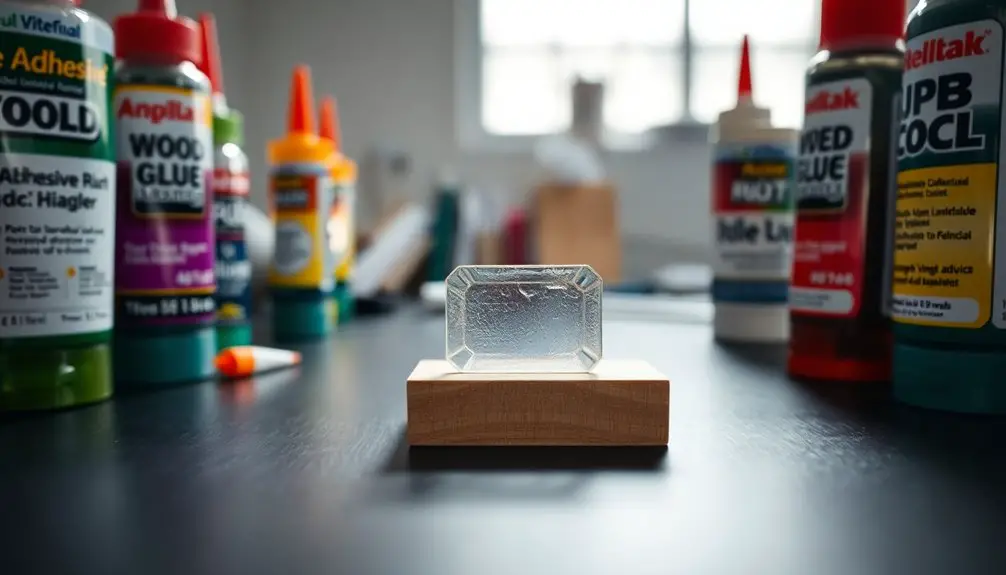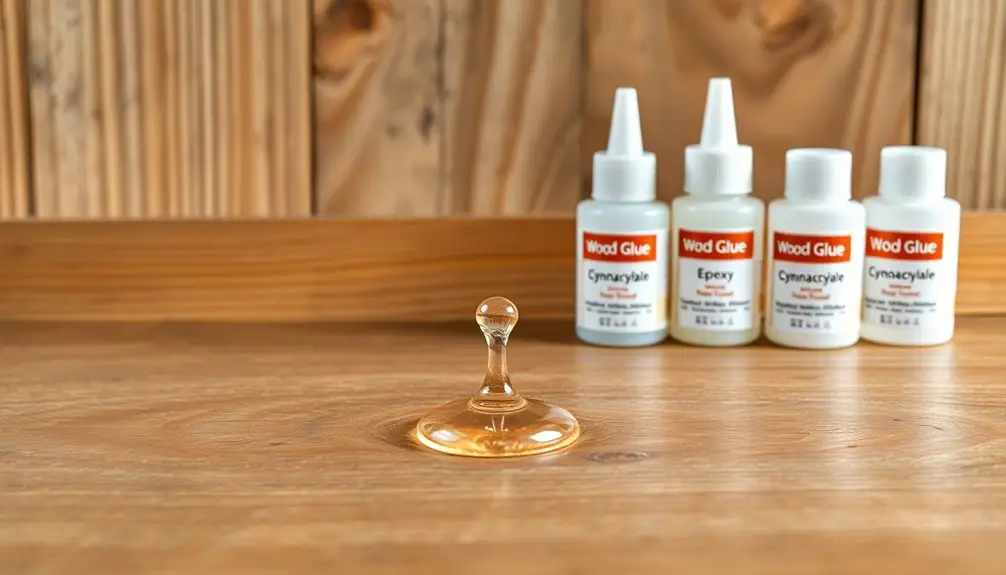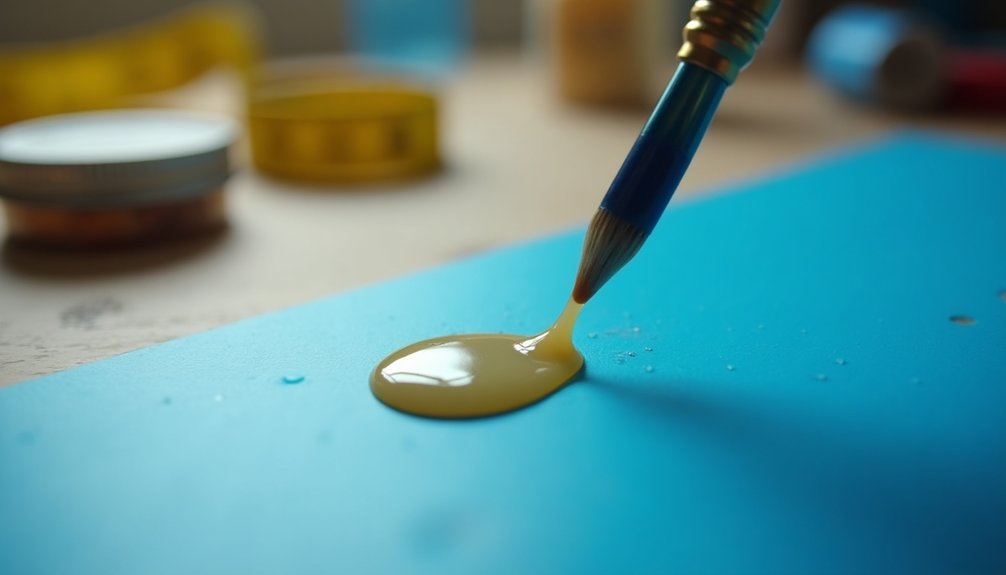Wood glue isn't effective for bonding plastic, as it's designed for porous materials like wood. You'll find its adhesion to non-porous surfaces like plastic is weak and unreliable. For better results, consider alternatives like epoxy, cyanoacrylate, or specialized adhesives based on the type of plastic you're using. For instance, epoxy works great on polycarbonate, while cyanoacrylate bonds quickly to ABS. Also, prepare the surfaces by cleaning and roughening them for optimal results. Understanding your adhesive options will ultimately help you achieve stronger, more durable bonds, so stick around to explore the best choices for your projects!
Key Takeaways
- Wood glue is ineffective for bonding plastics, resulting in weak and short-lived connections.
- Common wood adhesives like PVA, hide glue, and polyurethane do not adhere well to non-porous surfaces.
- For reliable plastic bonding, epoxy, cyanoacrylate, or specialized adhesives like MMA are recommended.
- Surface preparation, including cleaning and roughening, is crucial for achieving strong adhesive bonds on plastics.
- Understanding the type of plastic is essential to select the appropriate adhesive for effective bonding.
Understanding Wood Glue Limitations
When it comes to choosing the right adhesive for your project, understanding wood glue's limitations is crucial. While wood glue excels at bonding porous wood surfaces, it struggles with non-porous materials like plastic, metal, or glass. If you're considering using wood glue on plastic, be aware that the bond may not be strong or long-lasting. For example, wood glue generally has trouble adhering to styrene, a common plastic in model building. The type of wood glue you choose also matters, and considering the properties of Surface Energy is essential for a successful bond.
The type of wood glue you choose also matters. PVA glue is the most common type but isn't ideal for plastic. Hide glue and polyurethane glue face similar challenges. If you need a reliable bond with plastic, epoxy is your best bet. It's designed for diverse materials and offers superior durability. Additionally, some fillers, such as DAP Plastic Wood, can improve the surface preparation and bonding quality when used correctly.
Additionally, proper surface preparation is key. Wood glue needs clean, dry surfaces, while plastic might require extra steps like cleaning or priming. Remember, the curing time can vary, and clamping is essential for wood but mightn't apply to plastic. After the bond, inspect for gaps and consider additional treatments for enhanced strength.
Types of Plastics and Adhesives
Choosing the right adhesive for different types of plastics can significantly impact the success of your project. Each plastic type has unique properties that require specific adhesives for optimal bonding. Understanding the surface energy of the plastic is crucial in selecting the right adhesive.
Here's a quick overview to guide you:
- Acrylic (PMMA): Use cyanoacrylate or UV curable adhesives for transparency and strength.
- Polycarbonate (PC): Epoxy and cyanoacrylate work well for impact resistance, as it is thirty times stronger than acrylic.
- Polyethylene (PE): Specialized epoxy or MMA adhesives are your best bet for flexibility.
- Polypropylene (PP): Opt for epoxy or cyanoacrylate with primer to ensure adhesion.
Understanding these variations can save you time and frustration.
For example, while cyanoacrylate is great for acrylic, it won't work effectively on polyethylene. Likewise, polypropylene requires specific adhesives due to its chemical resistance.
Always consider the application and environment of your project, as this can influence your adhesive choice.
With the right adhesive paired with the correct plastic, you can achieve strong, durable bonds for your projects.
Best Adhesives for Plastic Bonding

Finding the right adhesive for plastic bonding can make or break your project. If you're looking for strong and reliable options, consider these top adhesives.
First, Methacrylate (MMA) adhesives, like Infinity Bond MMA 500, are fantastic choices. They create permanent bonds with tough plastics like polyethylene and polypropylene, often requiring little surface preparation. This is particularly important because the low surface energy of these plastics makes bonding challenging for many adhesives. The use of surface energy treatments can significantly improve the bonding process for these materials.
With an open time of 4-5 minutes, they're ideal for industrial applications.
Next, solvent-based adhesives work well for PVC and acrylics. They dissolve surfaces partially, creating a lasting bond as the solvent evaporates.
This method ensures precision, especially in manufacturing and assembly.
For high-strength needs, ultrasonic bonding is excellent. It uses high-frequency vibrations to fuse plastic substrates, producing clean, residue-free bonds suitable for load-bearing applications in industries like automotive and aerospace.
Lastly, consider cyanoacrylate (CA) adhesives, commonly known as superglue. They bond quickly and effectively to polycarbonate and ABS, making them perfect for fast repairs.
Plus, they're widely available, ensuring you can easily access them for your DIY projects. Each of these adhesives brings unique strengths to your plastic bonding tasks.
Surface Preparation Techniques
To ensure a strong bond between wood glue and plastic, you need to focus on proper surface preparation techniques.
Start by roughening the surface to increase the bonding area, and then clean it thoroughly to remove any contaminants that could hinder adhesion. Moreover, effective surface preparation enhances adhesive receptivity, which is crucial for achieving a strong bond with plastic materials. Finally, applying a suitable primer can enhance the bond even further, setting you up for success.
Surface Roughening Methods
How can you ensure a strong bond between wood glue and plastic? One effective way is to roughen the surface of the plastic to increase the contact area for the adhesive.
Here are some methods you can consider:
- Sanding: Use sandpaper to create a rough texture, especially effective on plastics like PEEK and nylon.
- Chemical Etching: Apply chemicals to randomly etch the surface, enhancing bonding by increasing contact area.
- Wire Brushing: Scrub the surface with wire brushes to improve roughness and bond strength.
- Laser Etching: Utilize laser technology to create precise patterns that enhance surface roughness. Additionally, effective polishing can further improve overall surface quality, ensuring a better bond with adhesives.
Cleaning and Priming Steps
Effective cleaning and priming steps are crucial for achieving a strong bond between wood glue and plastic. Start by thoroughly cleaning your surfaces to remove dirt and grease. Use a suitable cleaner or degreaser; ensure it evaporates completely before moving on.
If soap and water aren't enough for plastics, consider using nitromethane-based debonders or rubbing alcohol. For wood, mix dish soap with warm water to soften any residual glue, then scrape it off gently with a plastic scraper—remember not to soak the wood. Additionally, removing glue from wood can be effectively done with nail polish remover or vinegar on a cotton ball for stubborn residues.
Next, apply an appropriate adhesion promoter, especially on low surface energy plastics like polypropylene or polyethylene. This step is essential for enhancing the bond. Use a cloth or brush to apply the primer, and allow it to evaporate completely.
Lastly, ensure your surfaces are dry and free from moisture. Wipe down with a clean cloth, and check for any remaining solvents. High humidity can also affect bonding, so keep an eye on the conditions.
Following these cleaning and priming steps will set you up for a successful adhesive application.
Industrial Adhesive Options

When it comes to choosing industrial adhesive options, understanding the variety of available types is crucial for achieving optimal results in your projects. Each adhesive has its unique properties, making them suitable for specific applications.
Here are some options to consider:
- Cyanoacrylate Adhesives: Known as super glue, they bond quickly and are versatile for various materials.
- Epoxy Adhesives: A two-component system that offers high shear strength and temperature resistance, perfect for demanding environments.
- Polyurethane Adhesives: These provide flexibility and durability, making them ideal for woodworking and automotive applications.
- Ceramic Adhesives: Designed for high-temperature and chemical resistance, suitable for specialized industries like aerospace.
Choosing the right adhesive can significantly impact the durability and effectiveness of your project. Additionally, some industrial adhesives, such as epoxy, are known for their strong bonding capabilities, making them essential for applications in electronics and plastics.
Cyanoacrylate is great for fast fixes, while epoxy offers strength for heavy-duty applications.
Polyurethane is your go-to for flexibility, and ceramic adhesives excel in extreme conditions. Effective removal of adhesives like PVC glue requires proper solvents to avoid damaging the surface or causing skin irritation.
Key Considerations for Adhesive Use
Selecting the right adhesive for your project involves several key considerations that can significantly influence the bond's effectiveness and longevity.
First, you need to assess material compatibility. Different adhesives work best with specific materials, so testing or consulting manufacturers can guide you in choosing the right one. Pay attention to the surface properties, such as roughness and rigidity, as these affect adhesion.
Next, consider bond strength. Think about the performance requirements, including load-bearing capacity and environmental conditions. Ensure the adhesive can withstand temperature, humidity, and chemical exposure relevant to your project. Standard testing methods can help you evaluate the adhesive's strength.
Application method is also crucial. Different adhesives suit various application techniques, whether you're using a spray, brush, or automatic processes. Proper surface preparation—like cleaning and priming—is vital for successful bonding.
Lastly, don't forget environmental considerations. Determine if your adhesive is suitable for indoor or outdoor use, and be mindful of storage conditions. When working with different materials, such as PVC and ABS, it's essential to understand chemical properties to ensure a strong and durable bond.
Considering these factors will help you select an adhesive that meets your project's specific needs and ensures a durable bond.
Frequently Asked Questions
Can I Use Wood Glue on Flexible Plastics?
You can't really use wood glue on flexible plastics. It won't bond effectively, leading to weak connections. Instead, opt for adhesives specifically designed for plastics to ensure a strong and durable hold.
What Happens if I Use Wood Glue on Plastic?
If you use wood glue on plastic, you won't get a strong bond. It's not designed for that material, and over time, the connection may fail, especially under stress or environmental changes.
Are There Any Exceptions for Using Wood Glue on Certain Plastics?
When considering using wood glue on certain plastics, you'll find it's generally not recommended. For plastics like ABS and nylon, opt for specialized adhesives like epoxy or CA glue for better results and stronger bonds.
How Do Humidity and Temperature Affect Wood Glue on Plastic?
Humidity and temperature significantly impact adhesive performance. In humid conditions, polyurethane adhesives perform better on plastics, while epoxy loses strength. For optimal results, apply glue within recommended temperature ranges to maintain bond integrity.
Can Wood Glue Be Used for Outdoor Plastic Projects?
You can't use wood glue for outdoor plastic projects. It's not designed for plastic bonding and won't hold up against moisture or temperature changes. Opt for specialized adhesives like epoxy or polyurethane instead.

